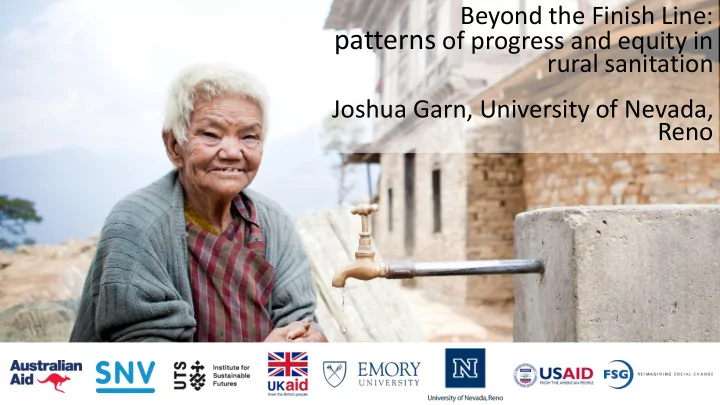

Beyond the Finish Line: patterns of progress and equity in rural sanitation Joshua Garn, University of Nevada, Reno
2 Introduction: Few countries on track Can we improve sanitation intervention effectiveness?
Objectives Can we improve sanitation intervention effectiveness? • Will discuss progress and lessons learned from various sanitation programmes attempting to increase sanitation coverage • Will present data from two studies: 1. Systematic review of literature assessing impacts of sanitation interventions on latrine coverage and use 2. 11 country, four-year evaluation of the SSH4A approach Assessed impact of intervention on sanitation coverage Assessed equity of sanitation uptake across vulnerability characteristics
Systematic review How do we increase WASH adherence? • Systematic review design: Included all studies from 1950 through 2015 Assessed impact of sanitation interventions on: change in sanitation coverage change in sanitation use • Used meta-analysis to summarize estimates
Systematic review results Sanitation coverage increased by +14 ppts overall • Of 2264 studies in our initial search, we found 27 studies that assessed impacts on sanitation interventions on sanitation coverage • Across these studies, the interventions increased sanitation coverage by +14 percentage points
Systematic review results Sanitation coverage increased by +14 ppts overall • While there were some successful studies, on average, the various intervention types did not do particularly well at increasing coverage
Systematic review Last mile most difficult • The baseline sanitation coverage levels were associated with coverage gains • We stratified results by baseline coverage levels • Lower baseline coverage levels had greater gains • Higher baseline coverage levels had smaller increases
Systematic review Sanitation use increased by +13 ppts overall • 10 studies assessing impacts on use • Overall increase in use of +13 ppts • Interventions also didn’t do a very good job of increasing use
Systematic review summary There is a need to improve sanitation interventions • Sanitation interventions often don’t do a very good job of increasing coverage and use • Some intervention types worked better than others • Even within specific intervention types, there was high heterogeneity (context matters) • Observed smallest gains in “last mile” populations
SSH4A evaluation methods SSH4A evaluation took place in 11 countries across 4 years • Data from rural areas in 11 countries, programme implemented by SNV (>12 million people programme population) • Cross-sectional household surveys in same areas over time At baseline and three follow-ups • Multi-dimensional intervention • Project timeline: Dec. 2015 – Jan. 2018 June 2014 Jan. 2017 Jan. 2016 Baseline Round 2 Round 3 Round 4
SSH4A: Objectives Assess impact on coverage and on equity of coverage • Assessed impact of intervention on increasing improved sanitation coverage • Also assessed equity of sanitation uptake across several vulnerability characteristics: Wealth quintiles Disability within Households (HH) Elderly within HH Female headed HH
SSH4A: Coverage of improved latrines Persistence of intervention across time may be important • Overall coverage increase of +47 ppts at endline • Persistence of intervention across time may be important Prevalence of improved sanitation 100 80 60 40 20 0 baseline round 2 round 3 round 4
SSH4A: Equity SSH4A was reaching vulnerable groups • SSH4A approach was reaching vulnerable groups • Closed some of the sanitation gaps between vulnerable and non-vulnerable groups (but wealth gap persisted) Prevalence of improved sanitation (%) at baseline and endline by vulnerable group 100 +54% +52% +59% +53% +48% +53% +53% +57% 90 80 70 60 50 40 30 20 10 0 Yes No Yes No Yes No Poorer Richer Female headed With disability With elderly Wealth quintiles Baseline (%) Round 4 (%)
SSH4A Summary of lessons learned • SSH4A is increasing coverage across many countries and contexts Persistent time in an area probably helpful to increase sanitation coverage An integrated approach might addresses more of the barriers • SSH4A is increasing coverage, even among the vulnerable groups that we assessed The SSH4A approach made considerable efforts to reach these vulnerable groups and to track progress among these groups
Limitations • No qualitative component in this particular research to explore all the reasons we got our observed results • Generalizability: Findings are generalizable only to rural settings in these countries Findings might not be generalizable to late adopters However, inclusion of many countries improves generalizability
Acknowledgements Questions? • Systematic reviews: WHO funding was made possible through contributions from the Department for International Development, UK and the Bill and Melinda Gates Foundation Authors: Joshua V. Garn, Gloria D. Sclar, Matthew C. Freeman, Gauthami Penakalapati, Kelly Alexander, Patrick Brooks, Eva A. Rehfuess, Sophie Boisson, Kate O. Medlicott, Thomas F. Clasen • SNV work This research is jointly supported by the Australian Government, UK Department of Foreign Affairs (DFID) and SNV Sustainable Sanitation and Hygiene for All is supported by: the UK Department of Foreign Affairs and International Development (DFID) in Ethiopia, Uganda, Ghana, Zambia, Kenya, Mozambique, Tanzania, Nepal; the Australian Government in Nepal and Bhutan; the Stone Family Foundation in Cambodia; the Embassy of the Kingdom of the Netherlands in Indonesia Authors: Joshua V. Garn, Paschal A. Apanga, Matthew C. Freeman Special thanks to Antoinette Kome , Gabrielle Halcrow, Anne Mutta, and Antony Ndunga
Beyond the Finish Line: from coverage to sustainable rural sanitation services Panel discussion
Recommend
More recommend